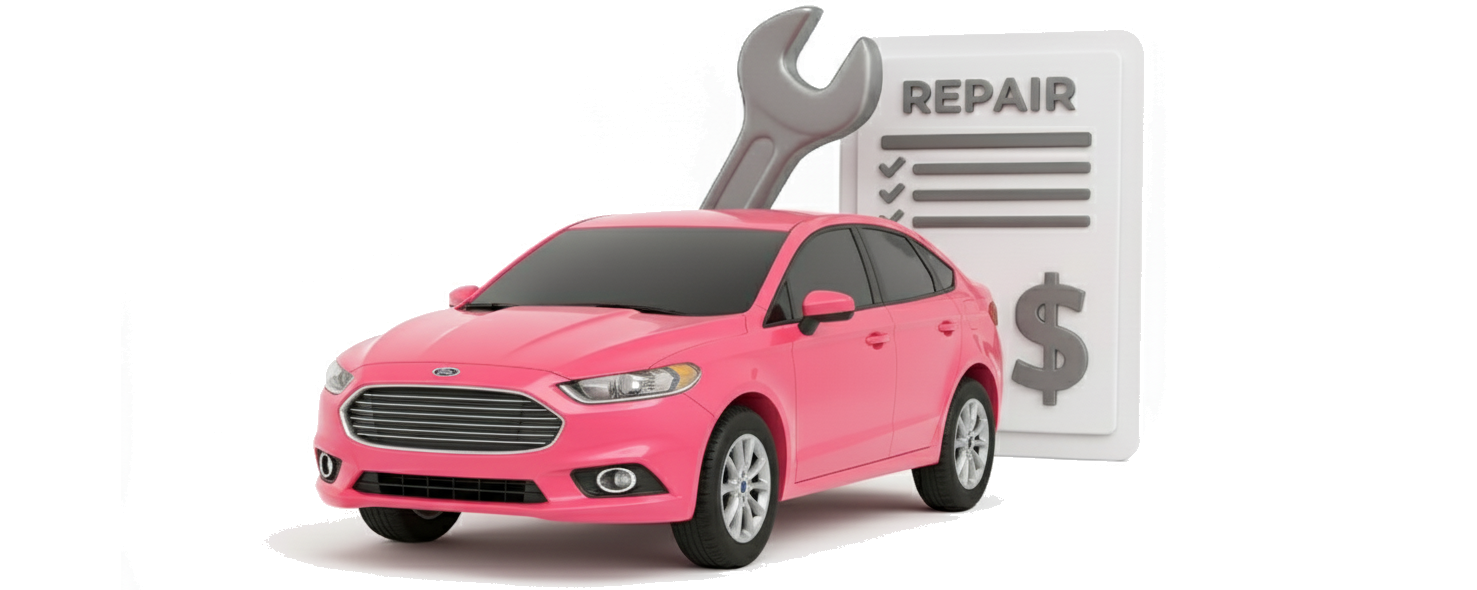Minor fixes like a hose or cap are often $50–$350 while the cooling system flush cost is usually $100–$150. Most vehicles run 2–4 hours of labor, plus parts and coolant.
If your radiator is leaking from a plastic tank or clogged internally, replacement is usually the most reliable fix for car radiator leak repair. Plan out repairs using the Jerry app, and join other customers who’ve found the right repair at the right price.
Real customers Jerry helped
While pricing can vary based on different factors like location, parts used, and exact vehicle, Jerry uses real customer experiences to show what drivers are paying right now. Here are some customer examples:
Estimates are modeled based on real vehicle and location data; names have been changed. Actual prices will vary by shop, parts, and vehicle condition.
What is a radiator?
Your radiator is the cooling system’s heat exchanger. Hot coolant leaves the engine, flows through thin tubes in the core, and then heat is carried away via air rushing through the fins. Most modern radiators use an aluminum core with plastic end tanks; some include built-in transmission or oil coolers. Electric fans pull air at low speeds, and a thermostat controls when coolant circulates.
Mechanic’s perspective: The usual failure on modern radiators is a crack along a plastic tank seam or the hose neck from age, heat cycles or overpressure (sticky cap or thermostat). Road debris can bend fins or puncture tubes. Old or incorrect/mixed coolant loses inhibitors and can trigger internal clogs or electrolysis that eats metal.
What are the signs I need my radiator replaced?
While a tech will confirm with a pressure test and visual inspection, Jerry customers are seeing these classic clues and signs of a bad radiator:
- Overheating or temperature spikes: Highway overheating suggests a restricted radiator; idle-only overheating points to fan/airflow.
- Visible coolant leaks: Colored puddles; white, red or green crust or wetness at tank seams or connections.
- Frequent top-offs or low coolant warning: Unexplained loss points to a leak.
- Sweet smell or steam: Hot coolant vapor smells sweet and steam from the grille area is a red flag.
- Sludgy or rusty coolant: Brown “mud” suggests internal corrosion or oil contamination—replacement and a thorough flush are likely.
- Crumbling fins or swollen plastic: Physical damage indicates the core or tanks are compromised.
- Pressure test fails: System won’t hold pressure at the radiator—often a cracked tank or core.
Remember: A bad water pump, thermostat, cap or fan can mimic radiator symptoms. Is it persistent bubbles in the overflow, or is it rapid pressure buildup from cold? Do a block test before authorizing a radiator.
Cost breakdown: Why the price varies
Radiator work has a wide range because several factors stack up. Here’s how each one typically moves the needle for Jerry customers, so you can sanity-check any quote:
Vehicle and engine layout:
Tight bays, turbo plumbing or front-end tear-down add 1–2 hours of labor ($100–$300+ depending on rates).
OEM vs. aftermarket parts:
Original equipment manufacturer (OEM) parts can be 30–80% more. Quality OE-supplier brands (Denso, Valeo, Nissens, CSF) often offer strong value. Expect a $100–$400 swing depending on choice.
Plastic tank vs. all-metal:
Modern plastic/aluminum radiators are replaced as a unit. Metal re-cores are rare, but they can add $200–$600 over standard units.
Extent of damage:
The cost to fix a radiator leak varies based on need. A cracked hose ($50–$350) or a leaking tank seam are less serious than crushed fins or internal clog that often means full replacement ($450–$1,200+).
Cooling system add-ons:
Integrated trans/oil coolers add complexity—often $50–$200 for lines, fittings and extra time.
Corrosion/seized fasteners:
Assorted parts – old clamps, rusted bolts or brittle hoses can add 0.5–1.0 hour and $20–$100.
Related maintenance:
Fresh coolant ($20–$60), a new cap ($10–$40) and upper/lower hoses ($40–$150 each part, plus 0.5–1.0 hour total) can add $100–$350.
Thermostat or fan issues:
If found, add $150–$350 (thermostat) or $300–$700 (fan assembly).
Shop type and location:
Dealer rates can be 20–50% higher than independents. Also, urban/coastal markets may add $100–$300 over averages.
Coolant type and volume:
Some European/long-life coolants cost more and larger engines need more fluid—expect a $20–$60 difference. Use the correct spec and don’t mix types.
Pro tip: If the radiator is original and over 8–10 years old, consider preventive hoses/clamps and a thermostat while the system is open. Paying for coolant twice is the real budget killer.
Confirm the repair:
Check coolant level, look for colored puddles and inspect for crust on radiator tank seams/neck. Check for visible damage to the radiator such as holes or crushed fins.
Ask for a line-item quote:
Get radiator brand, billed hours and labor rate, coolant type/quantity, shop fees and warranty (12/12 to 24/24) in writing. OE-supplier parts (Denso/Valeo/Nissens/CSF) are solid bets. Ask for evidence or photos of the leak or failure and make sure to check for TSBs or extended coverage on known failures.
Replace wear items while open:
Hoses, clamps and a cap usually add under $200 and prevent paying for coolant and labor twice.
Avoid stop-leak unless it’s a limp-home emergency:
It can clog heater cores and small passages causing overheating.
Verify airflow:
Bent A/C condenser fins, debris or a weak fan can mimic radiator problems. Fixing airflow can save you from unnecessary parts.
Benchmark your price:
Compare multiple written quotes to find a fair price for your car and location.
Pro tip: After the fix, recheck coolant after 2–3 heat cycles, inspect seams and trans-line fittings for weeps, and then confirm fans engage and both hoses warm at operating temp.
DIY vs. Pro: Can I do this myself?
Replacing your own radiator is doable for an experienced DIYer with time, tools and careful bleeding. Here are a few comparisons to help you decide, but be sure to compare pricing and confirm diagnostics with Jerry’s tools before forging ahead:
If you DIY: Follow a service manual, use new clamps, vacuum-fill if required and verify fan operation. One bad bleed can overheat an otherwise healthy engine.

Related repairs
When you’re in the cooling system, some “while-you’re-there” items are a smart value. Here are the repairs and ranges for services that Jerry customers are bundling:
- Coolant flush and bleed: $100–$150.
- Upper/lower radiator hoses and clamps: $100–$350 total (radiator hose replacement cost).
- Radiator cap: $10–$40.
- Thermostat and housing: $150–$350.
- Cooling fan assembly: $300–$700.
- Water pump (varies widely): $353–$413.
- Heater core (if clogged/leaking): $626–$1,300.
- Serpentine belt (if driving water pump): $121–$250.
Pro tip: If your radiator includes a transmission cooler, ask the shop to replace quick-disconnect O-rings/clips and check for cross-contamination. Milky fluid in either system needs immediate attention.
When you’re ready to tackle your radiator job and see local parts options and warranties, download the Jerry app.
What our customers are asking
-
Is it safe to drive with a leaking radiator?
-
Can I just use stop-leak?
-
Do I need a thermostat or hoses with my radiator?
-
How long does a radiator last?
-
How long does radiator replacement take?
-
How can I prevent radiator problems?
-
How do I tell if it’s a head gasket vs. radiator?
-
Why is my fluid dark?

Spencer Clayton is a mechanic, writer and fabricator who has hands that know their way around engines and a passion for storytelling. He’s diagnosed complex faults, built high performance engines and custom fabricated everything from fine detail parts to entire chassis while sharing how things work and why they matter. His background in everything from dealership technician work to building high performance cars spans a large breadth of experience, and he is driven by a love of all things automotive and a desire to share knowledge.

Steve Kaleff began working on cars at the very young age of nine years old, when his dad actually let him make fixes on the family car. Fast forward to the beginning of a professional career working at independent repair shops and then transitioning to new car dealerships. His experience was with Mercedes-Benz, where Steve was a technician for ten years, four of those years solving problems that no one could or wanted to fix. He moved up to shop foreman and then service manager for 15 years. There have been tremendous changes in automotive technology since Steve started his professional career, so here’s looking forward to an electric future!

Nick Wilson is an editor, writer, and instructor across various subjects. His past experience includes writing and editorial projects in technical, popular, and academic settings, and he has taught humanities courses to countless students in the college classroom. In his free time, he pursues academic research, works on his own writing projects, and enjoys the ordered chaos of life with his wife and kids.










